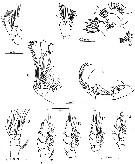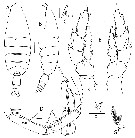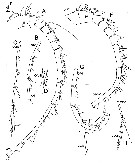|
|
 |
Fiche d'espèce de Copépode |
|
|
Calanoida ( Ordre ) |
|
|
|
Calanoidea ( Superfamille ) |
|
|
|
Megacalanidae ( Famille ) |
|
|
|
Bathycalanus ( Genre ) |
|
|
| |
Bathycalanus unicornis Björnberg, 1968 (F,M) | |
| | | | | | | Ref.: | | | Björnberg, 1968 (p.73, figs.F); Michel, 1994 (p.185, Rem.); Park & Ferrari, 2009 (p.143, Table 3, Appendix 1, biogeography from Southern Ocean); Bradford-Grieve & al., 2017 (p.123, Descr. F, M, figs. F, M, phylogeny) |  issued from : T.K.S. Björnberg in Antarctic Res. Ser., 1968, 11. [p.75, Figs; 1 A, B; 2, 3, 4]. Female (from SW Valdivia, Chile): 1A, forehead (lateral); 1B, idem (dorsal); 2, urosome (lateral right side); 3, habitus (dorsal); 4, A1. Nota: Rostrum formed by 2 sausage-shaped protuberances Presence of a conspicuous pointed horn on the forehead, below the horn, 2 minute setae are present. 5 thoracic segments, last thoracic segment laterally rounded. Urosome 4-segmented. Ratio of urosome to cephalothorax 1 : 2.5. Proportional lengths of the body segments to the caudal rami 324 : 81 : 64 : 54 : 43 : 54 : 64 : 43 : 27 : 16 : 43 = 1000. A1 25-segmented. Remark: The point of the horn is visibly broken off in both specimens examined; it may be much longer than represented in the figure.
|
 issued from : T.K.S. Björnberg in Antarctic Res. Ser., 1968, 11. [p.76, Figs.5-14]. Female: 5, A2; 6, Md (mandibular palp); 7, Mx1; 8, Mx2; 9, Mxp; 10, P1; 11, P2; 12, P3; 13, P4; 14, P5.
|
 Issued from : J.M. Bradford-Grieve, L. Blanco-Bercial & G.A. Boxshall in Zootaxa, 2017, 4229 (1). [p.123, Fig.81]. Female (from 13.32°N, 92.033°W): A-B, habitus (dorsal and lateral, respectively); C, forehead (lateral); D, P1 (anterior view); E, Mxp. Scale bars: 1.0 mm on all figures. Nota: -Forehead, in dorsal view, produces into single spine-like process, curved ventrally with ventral barb near tip. - posterolateral corners of pediger 5, in lateral view, symmetrical, short and rounded, not extending posterior to widest part of genital double-somote. - Genital double-somite symmetrical in dorsal view, widest at about anterior 1/8, 1.2 times longer than wide; seminal receptacles not observed. - A1 extending beyond caudal rami by about 5-6 segments. - Mxp syncoxal endite 4 longest, toothed seta extending beyond distal border of endopodal segment 2. - P1 exopod with articulation between exopodal segments 2 and 3 well developed; distolateral corner of endopodal segment 1 bilobed.
|
 Issued from : J.M. Bradford-Grieve, L. Blanco-Bercial & G.A. Boxshall in Zootaxa, 2017, 4229 (1). [p.124, Fig.82]. Female A1 ancestral segments: A, segments I-XV; B, segments XVI-XVIII; C, segments XIX-XXII; D, segments XXIII-XXVIII; E, detail of segment XXVIII. Scale bars: 1.0 mm (A-D; 0.1 mm (E). Nota: Anterior and posterior borders of ancestral segments XVI-XXI smooth.
|
 Issued from : J.M. Bradford-Grieve, L. Blanco-Bercial & G.A. Boxshall in Zootaxa, 2017, 4229 (1). [p.1235 Fig.83]. Female: A, A2; B, md palp; C, Md gnathobase; D, Mx1; E, Mx2; F, endopod of Mx2. Scale bars: 1.0 mm (E); 0.1 mm on remaining figures. Nota:
- A2 exopod segment IV with short seta extending to distal border of segment VIII and bearing short setules.
- Mx1 praecoxal arthrite with 14 setae including 3 on posterior surface and 2 setae on anterior surface, one of them small; coxal endite without setae; basal ebdites 1 and 2 with 2 and 4 setae, respectively; endopodal segments with 2/3, 2, 5+1 smaller snterior surface seta.
|
 Issued from : J.M. Bradford-Grieve, L. Blanco-Bercial & G.A. Boxshall in Zootaxa, 2017, 4229 (1). [p.126, Fig.84]. Female: A, P2; B, P3; C, P4; D, P5. All legs from anterior view; Scale bar = 1.0 mm on all figures.
|
 Issued from : J.M. Bradford-Grieve, L. Blanco-Bercial & G.A. Boxshall in Zootaxa, 2017, 4229 (1). [p.127, Fig.85]. Male (from 13.32°N, 92.033°W): A-B, habitus (dorsal and lateral, respectively); C, forehead (lateral); D, ancestral segments XVIII-XXIII of right A1; E, P5 (posterior view); F, inner distal corner modified seta of right exopod segment 2 of P5; G, inner distal specialised seta of left exopod segment 2 of P5. Scale bars: 1.0 mm (A, B, E); 0.1 mm (C, D, F, G). Nota: - Forehead in dorsal view produced into single spine-like process curved ventrally, with ventral barb near tip. - In lateral view, posterior corners of pediger 5 rounded, extending almost to posterior border of urosomite 1. - A1 extends beyong caudal rami by about 5-6 segments on left. - P5 extending just beyond 3rd urosomite, asymmetrically developed; left leg slightly longer than right leg, outer borders of exopod segments without surface thickenings. Right exopodal segment 2, inner border seta in form of short thickened proximal part and apparently articulated tapering distal part. Inner border of right exopodal segment 3 naked apart from proximal setules. Left exopodal segment 2 inner border specialised seta in form of spherical proximal part with outer naked rounded lobe and inner pair of long lashes clothed in very long setules. Inner border of left exopodal segment 3 irregular in shape, bordered by setules from proximal to near inner spine.
|
 Issued from : J.M. Bradford-Grieve, L. Blanco-Bercial & G.A. Boxshall in Zootaxa, 2017, 4229 (1). [p.128, Fig.86]. Male ancestral antennule segments: Left A1 : A, segmenys I-XVIII; B, segments XIX-XXI; C, segments XXII-XXVIII; D, detail of segment XXVIII. Right A1: F, segments I-XV; G, segments WVI-XXIV; H, segments XXV-XXVIII. Scale bars: 1.0 mm (A-C,F-H); 0.1 mm (D). Nota: Left A1 similar to that of female. Right ancestral segment XVIII widened by anterior border ridge- 2ms, 1a; XIX with proximal ridge-1ms, 1 fused element with free tip, 1a; XX-with 1 long fused element with free tip, 1ms, 1a; XXI-XXIII-2 fused elements with free tips (proximal element largely overlapping distal element), 1a, 1 vestigial s?, 1ms.
|
 Issued from : J.M. Bradford-Grieve, L. Blanco-Bercial & G.A. Boxshall in Zootaxa, 2017, 4229 (1). [p.91, Table 10]. Morphological characters after identification key of Bathycalanus females and males. Compare to other species of genus. Main characters identification after species key : 1 - Mx1 coxal endite without setae. 2 - Anterior margin of head with 1 barbed spine-like ptocess in both sexes; male left P5 exopod segment 2 specialised seta with 2 setulose inner lashes, right exopod segment 2 with rudimentary inner distal seta.
|
 issued from : T.K.S. Björnberg in Antarctic Res. Ser., 1968, 11. [p.73]. Female: Proportional lengths of A1 segments . Nota: A1 25-segmented , over-reaches the body by 5.5 segmentss
| | | | | Ref. compl.: | | | Björnberg, 1973 (p.303, 384) | | | | NZ: | 3 | | |
|
Carte de distribution de Bathycalanus unicornis par zones géographiques
|
| | |  Issued from : J.M. Bradford-Grieve, L. Blanco-Bercial & G.A. Boxshall in Zootaxa, 2017, 4229 (1). [p.84, Fig.46]. Issued from : J.M. Bradford-Grieve, L. Blanco-Bercial & G.A. Boxshall in Zootaxa, 2017, 4229 (1). [p.84, Fig.46].
Distribution of Bathycalanus species;
Bathycalanus richardi (filled squareç; Bathycalanus bradyi (filled triangle); Bathycalanus milleri (open triangle); Bathycalanus dentatus (open square); Bathycalanus tumidus (open circle); Bathycalanus adornatus (open diamond); Bathycalanus pustulosus (filled star); Bathycalanus unicornis ( (filled diamond); Bathycalanus bucklinae (filled circle); Bathycalanus eximius (cross). |
| | | | Loc: | | | S Chile (Valdivia), NE Pacif. (off S Mexico), SE Atlant. (off Namibia: Abyssal plain).
Type locality: 40°46'S, 76°48'W. | | | | N: | 4 | | | | Lg.: | | | (406) F: 10,5-9,12; (1316) F: 9,3-10,2; M: 8,3-8,8; {F: 9,12-10,50; M: 8,3-8,8} | | | | Rem.: | Bathypélagisue.
Voir aussi les remarques en anglais | | | Dernière mise à jour : 07/08/2018 | |
|
|
 Toute utilisation de ce site pour une publication sera mentionnée avec la référence suivante : Toute utilisation de ce site pour une publication sera mentionnée avec la référence suivante :
Razouls C., Desreumaux N., Kouwenberg J. et de Bovée F., 2005-2024. - Biodiversité des Copépodes planctoniques marins (morphologie, répartition géographique et données biologiques). Sorbonne Université, CNRS. Disponible sur http://copepodes.obs-banyuls.fr [Accédé le 24 avril 2024] © copyright 2005-2024 Sorbonne Université, CNRS
|
|
 |
 |












